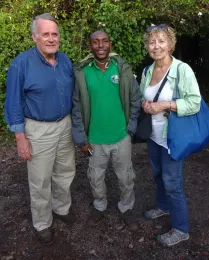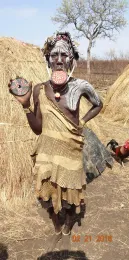
The live narrated video-seminar, hosted by the UC Davis Department of Entomology and Nematology as part of its weekly spring seminars, is based on video and pictorial content that he and his wife, Patty, recorded during vacations or on weekend trips during his annual teaching stints on the African continent over the last seven years.
“Although I include some entomological context, the main purpose of my talk is to enlighten everyone who attends about the remarkable—and moderately priced—travel opportunities in eastern and southern Africa,” Carey said.
"We drove over 12,000 miles in Sub-Sahara Africa, mostly self drive, including visits to or safaris in 25 national parks and 11 Unesco World Heritage sites in Kenya, Uganda, Botswana, Ethiopia, South Africa, Namibia, Congo, Swaziland, Lesotho and Tanzania," Carey said.
Carey will first set the stage with a brief overview of the African continent and follow with three parts:

Part 2: Natural wonders and sightseeing, centering on Table Mountain, Victoria Falls, Capes of Good Hope and Agulhas, Zanzibar, genocide and apartheid museums, livestock markets and a sudden flash flood.
Part 3: Indigenous cultures, covering singing fishermen of Lake Kivu, tribal peoples including Batwa pygmy, Hadza bushmen, Himba, Mursi and Dasenich tribes, and township tours of Langa and Soweto slums.
In his first African Odyssey presentation (standing-room only) to the UC Davis Department of Entomology and Nematology in April of 2015, Carey covered “African Odyssey: A Natural History and Cultural Journey Through Uganda, Namibia and Kenya.” Attendees praised it as “entertaining, innovative and fast moving.” (Watch presentation on YouTube.)
Carey received the 2015 Distinguished Teaching Award from the Entomological Society of America for his technological innovations, creativity and excellence in the UC system and beyond. He has taught video instruction methods for the 9-university Consortium for Advanced Research Training in Africa, including Nairobi and Uganda for seven years.
Carey, a senior scholar in the Center for the Economics and Demography of Aging at UC Berkeley, focuses his research on insect demography, mortality dynamics, health span and aging. Considered a pioneer researcher in biodemography, he served as the lead author of a seminal paper showing that mortality slows at advanced ages in fruit flies. He co-discovered “Carey's Equality” (life lived equals life left in stationary populations). Carey and population biologist Deborah Roach of the University of Virginia are authors of a soon-to-be-published book Biodemography: An Introduction to Concepts and Methods (Princeton).
Carey, who joined the UC Davis faculty in 1980 after receiving his doctorate in entomology from UC Berkeley, directed the federally funded program, “Evolutionary Ecology of Lifespan,” from 2003 to 2012, with projects ranging from the evolutionary of aging and the biodemography of nematodes and fruit flies to the longevity of red deer and soay sheep in Scotland and the health span in the Tsimani people of Bolivia.

